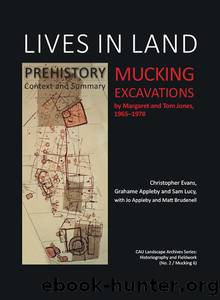Lives in Land â Mucking Excavations by Christopher Evans Grahame Appleby Sam Lucy

Author:Christopher Evans,Grahame Appleby,Sam Lucy
Language: eng
Format: epub
Tags: SOCIAL SCIENCE / Archaeology
ISBN: 9781785701498
Publisher: Casemate Publishers & Book Distributors, LLC
Published: 2015-12-31T00:00:00+00:00
Figure 4.42. RBI Enclosure, sections.
Table 4.3. RBI, pottery distribution by enclosure ditch-depth.
The main RBI Enclosure itself extended over 85 Ã 55m; with a âVâ-shaped profile its associated ditches were 3â4.0m wide and 1.4â2.3m deep (Fig. 4.42). Its 3.0m-wide entranceway, situated midway along its western side, was later closed with the insertion of a more minor ditch length; no gateway structure or the like was apparently recovered (Fig. 4.41). A kinking and narrowing of its ditch halfway along the eastern side might just attest to an opposed entranceway, but this would have been subsequently eradicated through re-cutting.
Dating and phasing of this enclosure is certainly problematic. On the one hand, that both Anglo-Saxon and Late Roman pottery was recovered from its upper profile would attest to its lingering earthwork survival; as detailed in the Roman volume, though, both a first-century AD kiln and a later Roman masonry structure cut its fills. On the other hand, as demonstrated by Table 4.3, only Middle Iron Age pottery was apparently recovered from its primary fills. Above this was a âcharcoal-richâ horizon in which quantities of âBelgicâ and Roman pottery (both Early and Late), along with Late Iron Age and Roman coins and brooches, occurred. While this may sound straightforward, the apparent complication of the enclosureâs sequence should be stressed. Hints of this are offered by photographic slides of deposits within its middleâupper ditch profile variously annotated âhearthâ and âclay layerâ. Certainly, we have here been unable to come to terms with its complexity, but the impression is that its excavation and recording did not do it justice, no doubt driven by pressing salvage need. This is conveyed in the record of the digging of a flexed inhumation burial (Grave 89). Located in the primary fills of the enclosureâs southeastern corner, its discovery only followed the reduction of the ditch by the dragline (Fig. 4.43). (A cremation was also recovered from within the ditch midway along its southern circuit [No. 86]; however, occurring in its upper profile and deposited in a grey ware urn, this was of Roman date.28)
Apparently after the mid first century AD, a second ditch (of far more minor portions) was added 3â3.5m outside RBIâs main circuit, at least along its eastern, southern and most of its western sides (Fig. 4.41); a gap in the latter indicates that the entrance on that side still functioned (there being no such break in its eastern line). Presumably this was undertaken to refurbish the enclosure and add an external bank/rampart (although there is no evidence of any revetment). Given this, there are three possible ways of interpreting the enclosureâs development. First, that it was simply established in the Middle Iron Age and left to slowly fill and linger as an earthwork, with the outer circuit added in the second half of the first century AD. The second option would be to have both the ditch circuits date to the Late Iron Age/Conquest Period (in which case, the Middle Iron Age wares would all be residual). The
Download
This site does not store any files on its server. We only index and link to content provided by other sites. Please contact the content providers to delete copyright contents if any and email us, we'll remove relevant links or contents immediately.
| Africa | Americas |
| Arctic & Antarctica | Asia |
| Australia & Oceania | Europe |
| Middle East | Russia |
| United States | World |
| Ancient Civilizations | Military |
| Historical Study & Educational Resources |
The Bomber Mafia by Malcolm Gladwell(1184)
Submerged Prehistory by Benjamin Jonathan; & Clive Bonsall & Catriona Pickard & Anders Fischer(1162)
Facing the Mountain by Daniel James Brown(1136)
The Dawn of Everything by David Graeber & David Wengrow(1112)
The Way of Fire and Ice: The Living Tradition of Norse Paganism by Ryan Smith(1033)
Wandering in Strange Lands by Morgan Jerkins(1019)
Tip Top by Bill James(1004)
Driving While Brown: Sheriff Joe Arpaio Versus the Latino Resistance by Terry Greene Sterling & Jude Joffe-Block(1003)
Evil Geniuses: The Unmaking of America: A Recent History by Kurt Andersen(1001)
Red Roulette : An Insider's Story of Wealth, Power, Corruption, and Vengeance in Today's China (9781982156176) by Shum Desmond(1000)
F*cking History by The Captain(969)
It Was All a Lie by Stuart Stevens;(944)
White House Inc. by Dan Alexander(908)
Evil Geniuses by Kurt Andersen(903)
Treasure Islands: Tax Havens and the Men who Stole the World by Nicholas Shaxson(881)
American Dreams by Unknown(860)
American Kompromat by Craig Unger(850)
The Fifteen Biggest Lies about the Economy: And Everything Else the Right Doesn't Want You to Know about Taxes, Jobs, and Corporate America by Joshua Holland(817)
The First Conspiracy by Brad Meltzer & Josh Mensch(814)
